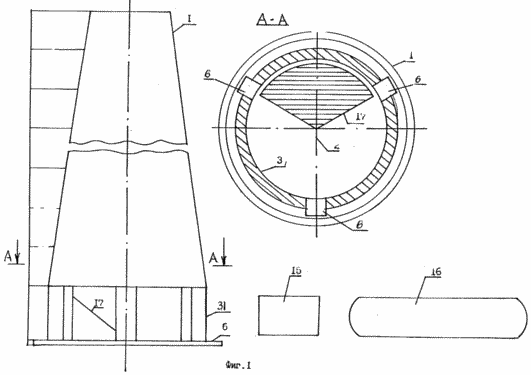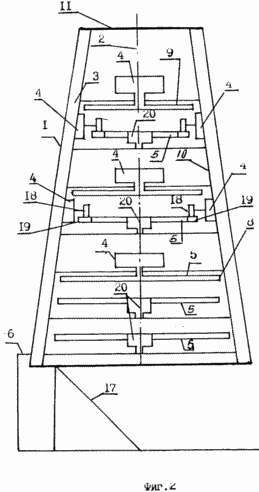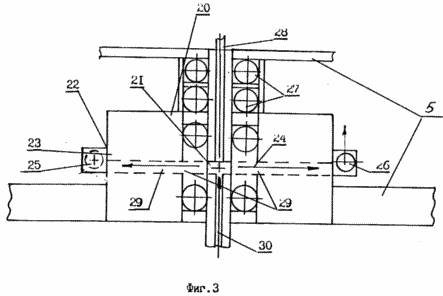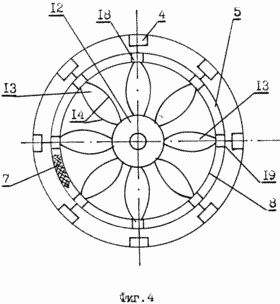| Start of section
Production, amateur Radio amateurs Aircraft model, rocket-model Useful, entertaining |
Stealth Master
Electronics Physics Technologies Inventions |
Secrets of the cosmos
Secrets of the Earth Secrets of the Ocean Tricks Map of section |
|
| Use of the site materials is allowed subject to the link (for websites - hyperlinks) | |||
Navigation: => |
Home / Patent catalog / Catalog section / Back / |
|
INVENTION
Patent of the Russian Federation RU2138684
![]()
DEVICE FOR CONVERSION OF AIR FLOWS TO ELECTRIC ENERGY
The name of the inventor: Alexander A. Rozhkov (BY)
The name of the patent holder: Alexander A. Rozhkov (BY)
Address for correspondence: 220113, Republic of Belarus, Minsk, ul.Ya.Kolasa 65, enterprise "Belpatentuservis"
Date of commencement of the patent: 1998.06.23
The invention relates to wind power, is directed to the use of wind energy and ascending air currents and can be used in the design and construction of thermo-air power plants. The technical result, which consists in increasing the efficiency of using a thermo-air power station by increasing the power through the optimal utilization of the useful working space of a pressure pipe, is achieved by the fact that the device comprises a pressure pipe coaxial with a central shaft shaft of which a wind electric generator with a wind impeller (hereinafter referred to as a wind wheel) , And at the base of the pipe there is an energy storage device, the wind wheel of the generator is equipped with a connecting inertial mass located in the peripheral part of the wind wheel. The device is equipped with two coaxial autonomous inertial lower and upper wind impellers. The axes of rotation of the generators are coaxial and / or perpendicular to the corresponding wind turbines, the lower wind wheel being kinematically not connected to the electric generator, but equipped with an air motor mounted coaxially with the lower wind wheel and made in the form of an air chamber, in the peripheral zone of which a jet device is arranged in the form of diametrically located Two nozzles on the opposite direction.
DESCRIPTION OF THE INVENTION
The invention relates to the field of power engineering and is aimed at the use of wind energy and rising air heat fluxes and can be used in the design and construction of thermo-air power plants.
One of the promising directions in the design and construction of wind power plants (VEU) is the development and creation of group complexes, including 20-30 units of tower-type wind turbines with a three-bladed wind wheel with a diameter of 15.4 m to 25 m and a three-section tower height of up to 25 m. ., For example, VVZubarev et al., "The Use of Wind Energy in the North", Leningrad, Nauka, 1989, p. 24-25).
The advantage of known complexes is manifested in a sufficiently high efficiency of converting wind energy into electrical energy. In California, about 4000 wind turbines are grouped into fifteen sizes with a capacity of 40-400 kW.
The disadvantage is manifested in the location of wind turbines in much larger areas up to 47 square kilometers and in the use of only wind energy without the practical use of solar thermal energy.
The prototype is the design of the TPS thermal electric power station (see, for example, US Patent No. 4070131, F 03 D 7/00, publ. 78.24.01) containing an open-ended tower. At the base of the tower's pressure tube, there is a wind energy storage generator, for example, a type of greenhouse. The main part of the tower has a tubular shape. In addition, the structure has a means for selectively directing wind within the tower along its vertical extent. The inner surface of the tower forms a vortex chamber in which the flow of air entering the tower swirls to form a low-pressure zone in the central part of the vortex. In the tower there is a means for sucking atmospheric air into the lower part of the tower and accelerating the flow of air in the low-pressure zone. At the base of the tower is installed a turbomachine, powered by a stream of air sucked through the lower part of the tower. The tower has several vertically mounted blades occupying the main portion of the vertical extent of the tower. The blades can rotate about their axis. The tower provides a means for determining the direction of the wind, with which a regulating mechanism is connected, providing the opening of the blades facing the wind to ensure the arrival of atmospheric air into the tower. The tower is set some distance from the ground. The turbomachine placed at the base of the tower has an electric generator and a turbine, whose blades are installed so that the turbine rotates in a horizontal plane, activating the electric generator. The turbine blades are located in close proximity to the base of the tower and are driven into rotation by a stream of air sucked into the low pressure zone.
The well-known construction of the TPS allows not only wind energy but also transforms the thermal energy of the sun to heat the air and, through convection, create an air upward flow of stable pressure in the zone of flow around the wind wheel of the wind electric installation.
The disadvantage of the known design is manifested in a small specific electric power, taken from one cubic meter of the working volume of the pressure pipe.
The invention is based on the task of increasing the efficiency of using TWES by increasing its power by optimally using the useful working space of the pressure pipe shaft.
The object is achieved in that in an apparatus for converting air streams into electrical energy containing a pressure pipe coaxially with a central shaft shaft of which a wind electric generator with a wind wheel (wind wheel) is installed and a power storage device is arranged at the base of the pressure pipe, the wind wheel The electric generator is provided with an attached inertial mass;
In the device for converting air currents to electrical energy, the connected inertial mass is located in the peripheral part of the wind wheel;
In the device for converting air streams, the pressure pipe is provided with at least two coaxial autonomous lower and upper wind impellers with inertia masses attached;
In the device for converting air flows, the lower wind wheel is not connected kinematically with an electric generator;
In the device for converting air flows, the rotational axes of the electric generators are coaxial and / or perpendicular to the corresponding wind impellers;
In the device for converting air streams, the lower wind impeller is provided with an air motor mounted coaxially with the lower wind blade impeller and configured as a pneumatic chamber in the peripheral zone of which a jet apparatus is arranged in the form of diametrically located at least two nozzles of the opposite direction;
In the device for converting air streams, the lower wind blade wheel is made in the form of a bicycle wheel, on whose adjacent spokes the blades are mounted.
The invention is explained in the drawing, wherein

1 shows a general view of the device.
 |
 |
 |
FIG. 2 is a section along AA; 3 shows a general view of an air motor; 4 shows a wind wheel in the form of a wheel.
A device for converting air streams into electrical energy comprises a pressure pipe 1 coaxial with a central shaft 2 of a shaft 3 of which a wind electric generator 4 is mounted with a wind impeller 5 (hereinafter referred to as a wind wheel) and an energy storage device is placed in the base 6 of the pressure pipe 1, Which can be used an electric accumulator, a pneumatic accumulator, for example, based on pressure vessels with compressed air and the like. The wind wheel 5 is provided with an inertia mass attached 7, which can be used for metal loads, for example lead.
The attached inertia mass 7 is located in the peripheral part 8 of the wind wheel 5.
The pressure pipe 1 is provided with at least two coaxial independent inertial lower and upper wind impellers 5 and 9. The device can be used in embodiments of either purely coaxial coupling of the electric generator 4 to the wind wheel 5 or the horizontal arrangement of the electric generator 4 with respect to the wind wheel 5 or Any combination of the kinematic and electrical connection between the wind wheels 5 and the generators 4. At the same time, a certain number of windscreens 5 can be used purely autonomously as vortex generators without a kinematic relationship with the generators 4, but only with pneumatic coupling to the wind wheels 5, which in this design are associated with Electric generators 4.
The lower wind wheel 5 can be structurally not connected kinematically with the electric generator 4 and in such a construction the lower wind wheel 5 serves as the vortex generator of the ascending airflow inside the discharge pipe 1.
Wind-wheel 5 for optimizing the differential use of the energy of the ascending airflow in the pressure pipe 1 can be made of different diameters, the value of which decreases from the lower 5 of the wind wheel to the upper wind wheel 9. In this embodiment, the inner surface 10 of the shaft 3 of the pressure pipe 1 is conically shaped with a decrease in the conicity from the base To the upper cut 11 of the discharge pipe 1.
In one embodiment of the device, the wind wheel 5 can be made in the form of a bicycle wheel 12 (in FIG. 4) in which the blades 13 are placed on adjacent opposing spokes 14, which is technologically feasible, since the spokes 14 allow the blades 13 to form an optimal angle of attack With respect to the upward airflow within the discharge pipe 1. The attached mass 7 in the form of loads is technologically positioned in the peripheral zone of the rim of the bicycle 12. As additional energy storage devices, for example, electric accumulators 15 or underground compressed air tanks 16 for Application in meteorological conditions of a calm type. The batteries 15 are recharged from the power generators 4 during the operation cycle of the device. Tanks 16 are filled with compressed air from electric or mechanical compressors (not shown). At the base of the device, there is an inclined guide 17 for adjusting the air flow from the environment to the barrel 2 of the pressure pipe 1. The power take-off shaft of the electric generator 4 in one embodiment, with the generator 4 being horizontally positioned, is provided with a roller 18 forming a friction pair with the rim 19 of the wind wheel 5 , 9. The rim 19 forms a peripheral region 8 of the wind wheel. To control the incoming natural air streams into the working zone of the pressure pipe 1, the latter are provided with shutter curtains controlled in manual or automatic operation.
In one embodiment, in the air flow converting apparatus, the lower wind bladed impeller 5 is provided with a pneumatic motor 20 that is mounted coaxially with the lower wind bladed impeller 5 (above the swept surface of the wind wheel 5 or under the swept surface of the wind wheel 5) and is in the form of an air chamber 21, Zone 22 of the body 23 of which the jet apparatus 24 is disposed in the form of diametrically tangentially arranged two nozzles 25 and 26 of the opposite direction. The housing 23 of the pneumatic motor 20 is mounted on the shaft 28 of the blade rotor 5 rotatably with respect to the shaft 28 together with the wind wheel 5 by means of a bearing support. The nozzles 25 and 26 are pneumatically connected to the main duct 30 connected to the compressed air accumulator 16 or to the air Compressor (not shown). The air motor 20 is used to untwist the inertial wheel of the wind wheel 5 for the period of the fall in the power of the natural airflow in the barrel of the pressure pipe 1. When the power of the natural airflow falls along the main channel 30, compressed high pressure air is supplied from the compressed air accumulators 16 to the jet apparatus 24 of the nozzles 25 and 26 The jet air jet flowing out of the nozzles 25 and 26 drives the body 23 of the air motor 20 and, together with it, the wind wheel 5 (according to the "Segner wheel" principle).
Depending on the weather conditions during the operation of the device the following factors are taken into account:
- use of wind force;
- use of natural atmospheric pressure;
- use of the temperature difference in the base of the pressure pipe and in the zone of its upper cut;
- the use of compressed air from high pressure tanks - an air energy battery;
- variation of the absolute pressure within the pressure pipe due to the features of its design;
- use of forced fans, powered by electric accumulators.
A special feature of the device is the construction of a pressure pipe 1 with an inner cone-shaped surface mounted on a three- and four-base base 6. Inside the pressure pipe 1, wind wheels 5 are mounted with inertial masses attached (hereinafter inertial windwheels 5) driven by a wind flow with six Above factors. The inertial wind wheels 5 transmit rotation energy to electric generators 4 due to one of the kinematic schemes of their connection to the latter. If the generators 4 are located in mounting sockets constructed inside the wall of the pressure pipe 1, the generators 4 are driven by a friction pair: the contact roller 18 of the generator 4 - the rim 19 of the wind wheel 5, 9, which operate on the principle of a bicycle generator. The engagement of the contact roller 18 of the generator 4 with the rim 19 of the inertia wheel 5, 9 occurs in the mode: raising and lowering the contact roller 18 with respect to the rim 19.
In one embodiment, the generator 4 can be located coaxially with the inertia wheel 5, 9. In this case, an electric generator 4 of the execution 2 to 3 or more is used, depending on the rotational force of the inertia wheel 5, 9.
The combined use of the above six factors is included in the device operation.
The first mode of operation (wind)
The first mode of operation is the use of wind force. The movement of atmospheric air masses (air flow) enters the blinds 31 located in the supports of the base 6 of the pressure pipe 1 and along the inclined guide 17 enters the barrel 2, forcing to rotate 2-3 wind, for example, inertia wheels 5, which are not connected with Electric generator 4, but serve to amplify the air flow in the barrel 2 of the pressure pipe 1 and impart a turbulent (vortex) motion to the air flow. Due to the conicity of the pressure pipe 1 and the operation of the wind inertia wheels 5, the increased air flow rotates the workers kinematically connected, for example, with electric generators 4, inertial wheels 9. In the absence of wind masses, a combined operation mode is activated.
The second mode of operation (combined)
The combined operation mode involves the use of compressed air from high-pressure reservoirs 16 which automatically turn on in the absence of wind. The high-pressure compressed air should be calculated for the period of maximum calm-calm time for a given area (in the presence of wind, the reservoirs are automatically filled with compressed air). Similarly, the electric power storage device-accumulators 15-is activated, which are powered by electric current (include) forced fans (not shown) located below the level of the wind inertia wheels 5. Also, an air heater (not shown) is turned on and must be located at the level Wind inertia wheels 5, and thus the air heater creates a temperature difference in the base 6 of the pressure pipe 1 and at the level of its upper cut 11, thereby enhancing the energy of the wind head of the device providing the use of an air cooler to create a temperature difference inside the barrel 2 and to increase the energy of the air Flow. The claimed device can be used in barrels of abandoned mines.
The advantage of the device is that, unlike previously known wind installations, it has a constant mode of operation and does not depend on direct wind currents, as known installations, since it has a combined operating mode described earlier. The device does not require large costs, unlike nuclear and hydroelectric power stations, it can be configured as a cascade, or small objects.
The power of each variant of the claimed device will be determined depending on the demand for the electric power of the consumer and the size of the plant being built.
At the date of application, the author carried out a prototype test of the device using a bicycle wheel as a base for a wind wheel. As an electric generator, bicycle and automobile generators were used. The attached inertia mass 7 was placed in the tire of the bicycle wheel. The blades were mounted on the opposing spokes of the bicycle wheel. Due to the fact that the spokes are located in the direction of the chord of the wheel, the blades have a double inclination to the plane of the wheel, which corresponds to the optimal angle of attack of the blades of the wind wheel 5 in relation to the ascending airflow inside the barrel 2.
Industrial use of the device will be carried out in Belarus after the identification of the inventory of inactive pressure pipes of boiler houses, thermal power plants, etc.
CLAIM
1. An apparatus for converting air streams into electrical energy comprising a pressure pipe coaxial with a central shaft shaft of which a wind electric generator with a wind impeller is installed, and an energy storage device is disposed in the base of the pressure tube, characterized in that the wind wheel impeller of the electric generator is provided with an attached Inertial mass, which is located in the peripheral part of the wind impeller.
2. The device according to claim 1, characterized in that it is provided with at least two coaxial autonomous inertial lower and upper wind blades.
3. Apparatus according to claim 1 or 2, characterized in that the rotational axes of the electric generators are coaxial and / or perpendicular to the corresponding wind impellers.
4. The device according to claim 2 or 3, characterized in that the lower wind impeller is not kinematically connected to the electric generator.
5. The device according to any one of claims 2 to 4, characterized in that the lower wind impeller is provided with an air motor mounted coaxially with the lower wind impeller and configured as a pneumatic chamber in the peripheral zone of which a jet device is arranged in the form of a diametrically arranged two nozzles of a counter directions.
print version
Date of publication 10.02.2007gg




Comments
When commenting on, remember that the content and tone of your message can hurt the feelings of real people, show respect and tolerance to your interlocutors even if you do not share their opinion, your behavior in the conditions of freedom of expression and anonymity provided by the Internet, changes Not only virtual, but also the real world. All comments are hidden from the index, spam is monitored.